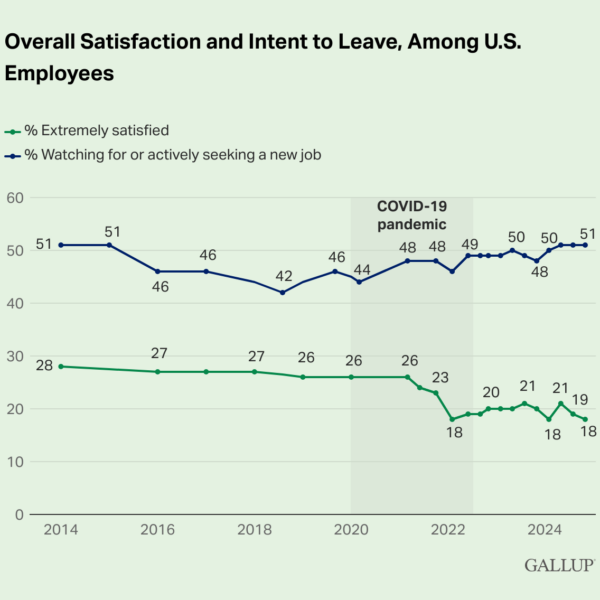In the wake of The Great Resignation, another workplace phenomenon is taking shape: The Great Detachment.
Unlike The Great Resignation, where workers left jobs in droves, The Great Detachment is characterized by widespread disengagement.
Many employees feel stuck in their current roles due to economic uncertainty, stock market volatility and high inflation, which have slowed hiring.
According to a recent Gallup report, employee satisfaction has plummeted, with only 18% of employees finding their jobs fulfilling. Meanwhile, 51% of American workers are either actively job hunting or keeping an eye on new opportunities — the highest percentage since 2015.

Overall-Satisfaction and Intent to Leave Among U.S. Employees, Gallup
As a result, businesses may be experiencing lower turnover, but they face another major problem: a disengaged workforce that is less productive and less motivated. If left unchecked, this could result in another mass exodus when the job market improves.
The Root Causes of The Great Detachment
Several key factors are contributing to this new era of workplace detachment. Understanding these factors is critical for businesses looking to re-engage their workforce and prevent long-term productivity losses.
Rapid Organizational Change
Over the past few years, businesses have undergone rapid digital transformation, restructuring and leadership changes. While change can be necessary for growth, too much too quickly can leave employees feeling uncertain about their future. Employees who once felt a sense of stability and purpose now struggle to adapt to constantly shifting priorities, unclear expectations and evolving roles. When people feel like they are merely trying to keep up rather than actively contributing to success, they disengage.
Hybrid and Remote Work Growing Pains
While many employees appreciate the flexibility of remote and hybrid work, it has also led to unintended consequences. Poor communication, lack of collaboration and the erosion of company culture can leave employees feeling disconnected. Inconsistent remote work policies, ineffective virtual leadership and an absence of meaningful interactions contribute to detachment. Many employees feel like they are working in isolation, missing out on the camaraderie and purpose that an office setting once provided.
Changing Customer Expectations
Shifts in customer behavior and expectations have placed more significant pressure on employees in industries such as healthcare, retail and customer service. Many workers report higher workloads, unrealistic performance expectations and increased stress levels as they try to meet new demands with limited resources. Without adequate support or recognition, employees quickly lose motivation and become disengaged.
Broken Performance Management Practices
Traditional performance management systems fail to meet today’s workforce expectations. Many employees feel unrecognized, undervalued and disconnected from leadership due to outdated evaluation processes. Infrequent feedback, rigid performance reviews and lack of career development opportunities contribute to employee frustration. Workers who see little room for professional growth or feel their contributions go unnoticed are far more likely to detach.
How Employers Can Reconnect With Their Workforce
If businesses want to prevent long-term disengagement and retain their best employees, they must take proactive steps to re-engage their workforce. Here are some strategies that can help:
Improve Communication and Transparency
Leaders need to foster open, honest communication to rebuild trust and engagement. Employees want to feel informed about company decisions, organizational changes and future goals. Regular town halls, transparent leadership updates and interactive Q&A sessions can make employees feel included in the company’s direction rather than alienated.
Prioritize Employee Well-Being
Burnout is a key driver of disengagement. Companies must invest in mental health resources, flexible work policies and realistic workload expectations to prevent employee exhaustion.
Offering work-life balance benefits like concierge services, wellness programs and additional paid time off can help alleviate some of the stress contributing to detachment.
Reinvent Performance Management
A more effective performance management system should focus on continuous feedback, goal alignment and professional development rather than outdated annual reviews. Companies should implement monthly check-ins, peer recognition programs and career growth discussions to ensure employees feel valued and motivated.
Strengthen Company Culture in Hybrid Work Environments
To combat the isolation of remote work, companies should invest in virtual team-building activities, mentorship programs and collaborative projects that foster a sense of belonging. Encouraging in-person meetups or hybrid events can also help remote employees feel more connected to their colleagues and the company’s mission.
Provide Meaningful Career Growth Opportunities
One of the biggest reasons employees detach is the lack of career advancement opportunities. Companies should offer clear pathways for promotions, reskilling initiatives and leadership training. Employees who see a future within the company are far more likely to stay engaged and motivated.
Align Employee Expectations with Company Offerings
As Gallup researchers note, “Work-life balance and better compensation packages became more important to employees, along with expectations for remote work flexibility. A mismatch between what employees expect and what employers offer can leave employees feeling undervalued and questioning their future.” Employers must recognize these evolving expectations and ensure their benefits, policies and workplace culture reflect what employees truly want.
Final Thoughts
The Great Detachment is a wake-up call for employers. While turnover rates may have slowed, businesses must recognize that disengagement is just as damaging — if not more so — than employee attrition. Without meaningful changes, businesses risk losing top talent when the job market improves.
Employers can re-engage their workforce and turn The Great Detachment into The Great Reconnection by prioritizing employee well-being, transparent communication, better performance management and a strong company culture.
Now is the time for companies to rethink how they support, value and inspire their employees. The future of workplace engagement depends on it.